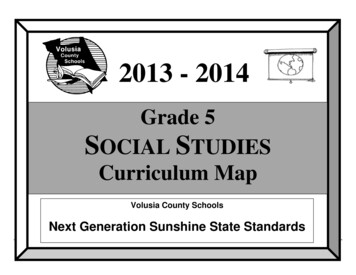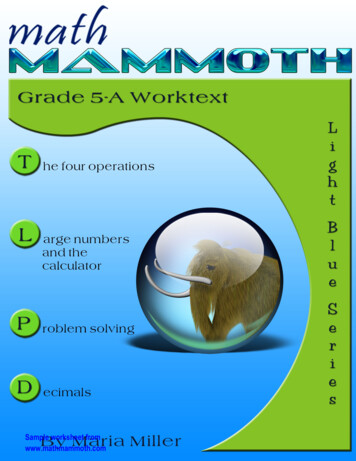
Transcription
FIFTH GRADEORGANISMS2 WEEKSLESSON PLANS ANDACTIVITIES
LIFE CYCLEOVERVIEW OF FIFTH GRADEORGANISMSWEEK 1.PRE: Identifying animal and plant cell parts.LAB: Exploring the different organelles of a cell.POST: Exploring the importance of RNA and DNA.WEEK 2.PRE: Explaining the importance of reproduction.LAB: Comparing asexual and sexual reproductive strategies.POST: Comparing characteristics of the 5 kingdoms.HUMAN BIOLOGYWEEK 3.PRE: Comparing functions of specific body systems.LAB: Calculating calorie intake.POST: Comparing how and where digestion takes place.WEEK 4.PRE: Comparing the three types of muscle tissue.LAB: Calculating reflex time.POST: Defining different components of the medical profession.PLANT LIFEWEEK 5.PRE: Analyzing the structure of plant cells.LAB: Observing different plants under the microscope.POST: Demonstrating photosynthesis.WEEK 6.PRE: Exploring the diversification of plant reproduction.LAB: Comparing reproduction of a gymnosperm and angiosperm.POST: Discovering how seeds are dispersed.NATURAL ENVIRONMENTWEEK 7.PRE: Exploring coral species.LAB: Exploring and distinguishing the different types of corals.POST: Discussing the requirements of corals.WEEK 8.PRE: Comparing autotrophs and heterotrophs.LAB: Exploring the eating habits of an owl.POST: Interpreting data obtained from owl pellets.Math/Science Nucleus 1990,20002
LIFE CYCLE - ORGANISMS (5A)Students construct a model ofa plant and animal cell.PRE LABOBJECTIVES:1. Identifying animal and plant cell parts.2. Constructing cell sconstruction paperscissorsglueBACKGROUND:Cells are the fundamental units of living material. The bodies of all living things areformed from cells, and without cells there would be no life. Every large living thing is madeof billions of cells.A cell contains special structures called organelles which have specific functions formaintaining the health of the cell. These functions include taking in food and breaking itapart into simple molecules, releasing energyfrom food, building and repairing cell parts,getting rid of harmful wastes, and making morecells.There are thousands of different kinds ofliving things that are made up of only singlecells. They are restrictive in what they can do,however, because one cell just can't conquerthe world.In most plants and animals, the cells areorganized to do different types of jobs. Inplants, for instance, there are specialized rootcells whose function is to take in minerals andwater. These specialized cells are arranged intotissues that do the same job. Muscle tissue, forMath/Science Nucleus 1990,20003
example, is made up of many individual muscle cells. Different tissues that work togetherform organs. Examples of organs include the stomach, kidneys, and lungs. Organs aregroups of tissues that work together to perform a specific function. Organs do not operatein isolation and together they form systems, like the respiratory, circulatory, and digestivesystems.PROCEDURE:1. Discuss the main organelles of a cell. Emphasize the importance of the nucleusand its function. Explain the differences between plant and animal cells, especially thepresence of chloroplasts and a rigid cell wall in plant cells.2. Have the students construct a paper model of a plant cell and an animal cell bycutting and pasting from the provided sheet. The major part is that the animal cell will nothave a cell wall and chloroplast.Math/Science Nucleus 1990,20004
LIFE CYCLE - ORGANISMS (5A)PREMath/Science Nucleus 1990,20005
LIFE CYCLE - ORGANISMS (5A)Students use a microscope toobserve plant and animal cells.LABOBJECTIVES:1. Discovering the differences betweenplant and animal cells.2. Exploring the different organelles of a cell.VOCABULARY:cell wallchlorophyllchloroplaststarch grainvacuoleMATERIALS:Swift-GH MicroscopesPrepared Microscope Kitonioniodine3 unknown samples of animal or plant slidesBACKGROUND:Cells are the fundamental units of living material. The bodies of all living things areformed from cells, and without cells there would be no life. Every large living thing is madeof billions of cells that have different sizes, shapes, and functions. Cells contain specialstructures called organelles which have specific functions for maintaining the health ofcells. The types of jobs that organelles perform include taking in food and breaking it apartinto simple molecules, releasing energy from food, building and repairing cell parts, gettingrid of harmful wastes, and making more cells.These organelles can help identify whether a cell comes from a plant or an animal.Only plants, for instance, have chloroplasts and starch grains. Chloroplasts are neededfor photosynthesis and starch grains (amyloplasts) store the starch that is produced byphotosynthesis. Vacuoles in an animal cell are not as large as those in plant cells.Learning the specific functions of the various organelles will continue in the post lab, so itis important that the students recognize and be able to distinguish the differences betweenanimal and plant cells.Math/Science Nucleus 1990,20006
PROCEDURE:1. Students have compared an ideal model of a plant cell with an ideal model of ananimal cell. However, when you look at real samples, the differences may not be asobvious as they were on the models.2. Have the students look at a thin slice of onion and animal cell as directed in thelab. Cut the onion skin very thin and put a drop of food coloring and then blot it. Use somehamburger meat and squish the cells on a glass slide. Make sure the students see that theonion cell has a thicker wall around each of the cells. This is the only real difference thestudents can see with the Swift-GH. You may want to use a higher magnification.3. Then have the students look at the 3 unknowns (pine stem x.s. [plant], hyalinecartilage tracheo region s.x. [animal], and bone cancellous sec. [animal]. The majordifference is the cell wall that can be seen in the pine stem.Math/Science Nucleus 1990,20007
LIFE CYCLE - ORGANISMS (5A)PROBLEM: What are the differences between animal and plant cells?PREDICTION:MATERIALS: MICROSCOPES, food coloring, 3 unknown samplesPROCEDURE: First examine a plant cell (onion) and an animal cell. Your instructor willgive you a small piece of onion skin. Put a drop of food coloring on the onion, and observe.Draw both the animal and plant cell.PLANT CELLANIMAL CELLDescribe the major difference between plant and animal cells.Now look at the 3 unknown samples. Draw what you see. Determine whether they comefrom an animal or a plant.UNKNOWN 1UNKNOWN 2UNKNOWN 3TYPETYPETYPECONCLUSION: How can you distinguish a plant cell from an animal cell?Math/Science Nucleus 1990,20008
LIFE CYCLE - ORGANISMS (5A)POST LABStudents color a DNA sequence.OBJECTIVES:1. Distinguishing different organelles.2. Exploring the importance of RNA and DNA.VOCABULARY:DNAgenemitochondrianuclear envelopeplasma e blueprint for the structure and functioning of our bodies is contained in thegenetic material found in the nucleus. The genetic material (chromatin) is composed ofDNA (Deoxyribonucleic acid) and protein. During certain times in a cell's life the chromatinwill condense and form x-shaped structures called chromosomes. Chromosomes arefound in the nucleus of cells at some time in their life spans. Human beings have 46chromosomes, arranged in 23 pairs. Heredity is encoded in DNA within the chromosomes.A gene is a very small cluster of chemical units which group up to form the DNA molecule.RNA (ribonucleic acid) is the messenger of DNA within the cell. Forms of RNA direct thecell to manufacture specific enzymes and other proteins. Modern biological research isdeveloping a much more complicated picture than what is described above. Students inthe fifth grade should learn the general outline and parts, but to really understand what isgoing on is not really completely known.DNA functions by carrying the template or "map" of chemical compounds, aminoacids, that are used to build proteins. DNA directs the production of proteins by providingthe sequence of amino acids necessary to produce specific proteins. Amazingly, there areonly 20 amino acids that are utilized to produce every protein in the human body. Ofcourse, certain "modified" amino acids exist, but these still require the starting 20 aminoacids. In order to gain an understanding of DNA, we must start at the heart of the matter,the cell.Math/Science Nucleus 1990,20009
This summary mainly is concerned with human cells but the basic theory holds formost organisms. Most human cells have a distinguishable central structure called thenucleus. The nucleus is the "storage area" for the cell's genetic material. The nucleushouses DNA and its corresponding helper molecule, RNA (ribonucleic acid). The nucleusis often referred to as being the "control center" of the cell and, the nucleus does in factregulate cell activity. This regulation is brought about under the influence of the geneticinformation that is housed in the cell. This genetic information informs the cell of whatactivities it is to undertake and what it is to accomplish. The cell carries out these "orders"by performing specific biochemical reactions, often times under the influence of enzymes(proteins that are catalysts) that are produced in the cell. The nucleus is the depository fornucleic acids (DNA and RNA). It is in the nucleus where DNA replication occurs.The sugar-phosphate backbone consists of deoxyribose sugar groups connectedtogether by phosphate groups. The sugar groups are, in turn, connected to the four bases:adenine, guanine, cytosine, and thymine. Adenine and guanine are called purines whilecytosine and thymine are called pyrimidines. The bases are often abbreviated as A, G,C, and T. A purine base can only bond to a pyrimidine base, and a pyrimidine only to apurine. Adenine will only bond with thymine and guanine will only bond with cytosine. Thenucleotide base pairs are held together by hydrogen bonds. It follows then that the numberof adenine bases will equal the number of thymine bases and the number of guanine baseswill equal the number of cytosine bases. This presumption led the way for the formulationof Chargaff's rules which was the basis of DNA investigation prior to the discovery of thedouble helical nature of DNA.DNA carries a template that determines amino acid sequences which are then usedto produce proteins at the ribosomes. Since proteins cannot produce other proteins DNAserves as a "storage" center for the amino acid sequences of all the proteins produced byan organism. A particular amino acid sequence that codes for a specific protein is calleda gene. The genes of an organism are stored in structures called chromosomes, whichare the familiar x-shaped structures often seen in biology books. An organism's DNA is notalways organized into chromosomes, rather these structures appear at particular timesduring the life cycle of a cell. A chromosome consists of DNA associated with a group ofproteins known as the histone proteins. DNA is a long, linear, polymer (poly many,mer unit) that if stretched out could be up to several or even thousands of meters long.One chromosome consists of a single molecule of DNA.Humans reproduce sexually through the successful union of a sperm and egg cell.The sperm and egg, referred to as gametes, contain one half the number of chromosomesfound in other human cells. When a cell contains one half the number of chromosomes itis referred to as being haploid. Conversely, when a cell contains the full number ofchromosomes it is referred to as being diploid. Human sperm and egg cells are haploidand contain 23 chromosomes. The diploid number for human cells is 46 chromosomes.When an egg and sperm unite each cell contributes 23 chromosomes and the resultingfertilized egg has 46 chromosomes. Through this mechanism genetic variability andheredity is expressed. Therefore a child will have received one half of his DNA from hismother and one half from his father. The traits that are then expressed in the child are afunction of which DNA (ie, the father's or mother's) was expressed. The study of how traitsMath/Science Nucleus 1990,200010
are inherited and passed on through generations is referred to as genetics.DNA has an analogous helper molecule called RNA (ribonucleic acid.) RNA'sstructure is similar to DNA's except in the following manners:1. RNA contains the sugar ribose, whereas DNA contains the sugardeoxyribose. Deoxyribose has one less oxygen than ribose, hencethe name deoxy-.2. RNA contains the base uracil instead of thymine.3. RNA is usually single stranded.PROCEDURE:1. Discuss with students DNA and RNA. Use the information above to help youdiscuss this important concept.2. Color the backbone which hold the pyrimidines (thymine and cytosine) andpurines (adenine and guanine). The small pentagon and circle.3. Color each of the pyrimidines and purines. The purine base adenine alwaysbonds with the pyrimidine base thymine, and guanine always bonds with cytosine.Math/Science Nucleus 1990,200011
LIFE CYCLE - ORGANISMS (5A)Math/Science Nucleus 1990,200012
LIFE CYCLE - ORGANISMS (5B)PRE LABStudents use a worksheet to compareasexual and sexual reproduction.OBJECTIVES:1. Comparing asexual and sexual reproduction.2. Explaining the importance of ATERIALS:worksheetBACKGROUND:Reproduction is important for the survival of all living things. Without a mechanismfor reproduction, life would come to an end. There are two types of reproduction to learnin elementary grades, asexual and sexual reproduction. Many teachers are afraid ofdiscussing reproduction, but if presented as a factual lesson it is easy for the students tounderstand the principles without the standard giggles.Asexual reproduction refers to simple cell division that produces an exact duplicateof an organism. There are many different types of asexual reproduction which can bediscussed to show students the variability of modes of reproduction. Some single-celledorganisms reproduce by simple cell division, this is called binary fission. In this manner,the mother cell simply splits in half producing two daughter cells. Some cells reproduce byunequal division of the cells, this is called budding. In this process the bud forms as a knobon the mother cell. The nucleus divides and identical parts go to the mother cell and thebud. The bud may grow until it is as large as the mother cell and can form buds of its own.In some cases buds remain attached to the mother cell. In others, they break away andlive as separate organisms.Sexual reproduction involves the joining of male and female sex cells. The spermrefers to the male sex cell and the egg refers to the female sex cell.PROCEDURE:1. As you discuss this with students, tell them that trees, fish, flowers, and manyother organisms have sperm and eggs. Tell students to look at organisms on their wayhome, to see if they can predict which ones reproduce by sexual or asexual means.Math/Science Nucleus 1990,200013
2. There are some reproductive strategies that are difficult to classify for students.Ferns, fungi, and some protozoa reproduce by spore production. Spores are formed bydivisions of special mother cells and are released from the parent organism. A single sporedevelops into a new organism.3. The worksheet shows students the difference between asexual and sexualreproduction. The answers are as follows: 1. yes; 2. in half; 3. little one celledcreatures; 4. zygote5. female, male, a baby; 6. larger organisms with organs; 7.larger organisms cannot simply divide, it is more efficient for little organisms to reproducein that manner.LIFE CYCLE - ORGANISMS (5B)Math/Science Nucleus 1990,200014
PREMath/Science Nucleus 1990,200015
LIFE CYCLE - ORGANISMS (5B)Students sort asexual and sexualreproduction.LABOBJECTIVES:1. Understanding asexual and sexual reproductive strategies.2. Exploring why large organisms reproduce ualMATERIALS:asexual/sexual sheetBACKGROUND:BinaryorganismsfissionLarger animals tend to reproduce sexually and smallerreproduceasexually. Larger animals have developed more complex organ systems and with theseorgan systems they can adapt to their environment more easily than smaller organisms.The complex brain and sense organs of larger organisms allows them to adapt to theirenvironment.Organisms that reproduce asexually cannot develop much variety, because they are"copying" the original organism almost exactly. Sexual reproduction allows for greatdiversity, because the zygote is different from the mother's egg and father's sperm; it is acombination of both. Sexual reproduction produces a greater chance of variation within aspecies than asexual reproduction would. This variation improves the chances that aspecies will adapt to his environment and survive.Heliozoa, Amoeba, and Euglena all reproduce by binary fission, which is the mothercell dividing into two daughter cells. The Heliozoa and Amoeba belong to the ProtistaKingdom. The Euglena is an odd one celled plant that sometimes have characteristics ofa protist. Heliozoa live in fresh water and have pencil like axopods that aid in eating.Amoebas live in fresh water, and move in a unique manner. An amoeba will move its entirebody in a "blobby" motion. Euglenas live in fresh water and have a long tail that helpsmove the organisms through the water.Planaria, round worms, and leeches are mostly hermaphroditic. The male andfemale reproductive systems are distinct, but may join terminally in a common chamber onthe same organism. Self fertilization is rare. Some of the representatives of these groupsare parthenogenetic: females asexually produce females. Planaria also are capable ofMath/Science Nucleus 1990,200016
extensive regeneration.Gorillas, elephants, rats, zebras, and dolphins are all mammals that reproducesexually. There is a male and female in each of these species. Kangaroos are mammalsbut they are marsupials. There are female and male kangaroos, but after sexualreproduction the fetus leaves the mother and goes into her pouch until it is large enoughto leave.Fish and frogs have sexual reproduction, but it is externally. The female lays eggsand the male externally fertilizes the eggs but squirting sperm in the water. Frogs developdifferently, in that they have a tadpole stage and them metamorphose into a frog.A turtle lays eggs, but like a bird and probably a dinosaur, fertilization occursinternally. Dinosaurs are extinct, but because we have found dinosaur eggs, we believethat they reproduced much like chickens. The male internally fertilized the female, and thenthe female laid her eggs.PROCEDURE:1. In this lab activity, have students cut out the pictures on the asexual and sexualreproductive chart.2. They are to divide the pictures into two groups, those that they predict wouldreproduce sexually and those that the believe reproduce asexually.3. The discussion after the grouping should be centered on how the organismsreproduce, and what characteristics seem to be more common in the sexual versusasexual modes of reproduction.Math/Science Nucleus 1990,200017
LIFE CYCLE - ORGANISMS (5B)PROBLEM: How can you determine which organism reproduces sexually or asexually?PREDICTION:MATERIALS: Asexual/Sexual Reproduction Chart, paper, gluePROCEDURE:1. After reviewing why some organisms will reproduce sexually versus asexually,cut out the organisms.2. Group the organisms into two categories, those that reproduce sexually andthose that reproduce asexually. Glue the two groups on two separate sheets.3. Determine from your categories what could be characteristic of the differentreproductive strategies.CHARACTERISTICS OF SEXUAL REPRODUCTIONCHARACTERISTICS OF ASEXUAL REPRODUCTIONCONCLUSION: Can large animals reproduce asexually? Why?Why don't little organisms reproduce sexually?Math/Science Nucleus 1990,200018
LIFE CYCLE - ORGANISMS (5B) LABMath/Science Nucleus 1990,200019
LIFE CYCLE - ORGANISMS (5B)POST LABStudents draw their own treeof life.OBJECTIVES:1. Comparing which organisms reproduce sexually and which reproduce asexually.2. Comparing characteristics of the 5 rotozoaMATERIALS:worksheetkingdom chartBACKGROUND:The reason for grouping into Kingdoms is not always obvious. The development ofa classification scheme probably started when humans began to think. Aristotle recordedhis classification scheme into vegetables and animals. There have been manyclassification schemes developed through time, changing from 2 kingdoms to 3 to 4 andto the present 6 kingdom system. Don't be surprised if this changes. There are manyorganisms that we simply don't know enough about.You may want students to bring in pictures of different organisms as a homeworkassignment. Have them classify their organisms within the 6 kingdom scheme. Have theclass decide where the organisms should go. Remember how the organisms eat andreproduce help to group the organisms.The simplest organisms are either bacteria or a blue-green algae and classified inthe large grouping of Monera. Monera has been recently divided into 2 major groups ofEubacteria and Archeobacteria. Both groups have a very simple nucleus that is notsurrounded by a nuclear envelope. The Archeobacteria are more ancient than theEubacteria. The Kingdom Protista or Protozoa is made up of one celled organisms thathave a nuclear membrane. Protozoa will eat their food and asexually reproduce morecommonly than they would sexually reproduce. The Fungi lack chlorophyll and absorb foodfrom the surrounding ground. Fungi possess organs and reproduce by sexual means(spores). The Plant Kingdom is characterized by its member's ability to reproduce by eithersexual or asexual means. The animal kingdom is divided into invertebrates andvertebrates. An animal eats its food and reproduces mainly by sexual means. Organs areMath/Science Nucleus 1990,200020
much more developed in the Animal Kingdom than in the other kingdoms.PROCEDURE:1. Discuss with students that living organisms are grouped into kingdoms so it iseasy for people to discuss them. Either make a transparency or use the enclosed masteras a worksheet to illustrate the common phyla within each kingdom.2. You may want to use the following summary:KINGDOMplantmonera (including Eubacteriaand ArcheobacteriaREASONmake own food, mainly greenone cell, primitive nucleusprotozoaone cell, eat foodfungiabsorb foodanimalmulticellular, eat food3. Give students the blank “Tree of Life” and have them draw what they think theorganisms look like.Math/Science Nucleus 1990,200021
LIFE CYCLE - ORGANISMS (5B)Math/Science Nucleus 1990,200022
LIFE CYCLE - ORGANISMS (5B) POSTMath/Science Nucleus 1990,200023
Math/Science Nucleus 1990,2000 2 LIFE CYCLE OVERVIEW OF FIFTH GRADE ORGANISMS WEEK 1. PRE: Identifying animal and plant cell parts. LAB: Exploring the different organelles of a cell. POST: Exploring the importance of RNA and DNA. WEEK 2. PRE: Explaining the importance of reproduction. LAB: Comparing asexual and sexual reproductive strategies. POST: Comparing characteristics of the 5 kingdoms.










